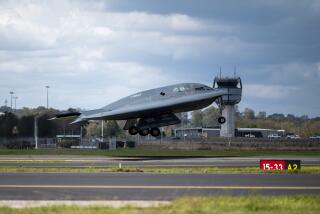U.S. Confirms Navy Jet Fired at Iran Fighter
- Share via
WASHINGTON — A Navy F-14 jet fighter, under orders to protect a U.S. surveillance plane, fired two missiles at a suspected Iranian jet that appeared to be preparing for an attack, the White House inadvertently confirmed today.
Administration sources, who demanded anonymity, said Monday night that the incident occurred over the weekend, shortly after U.S. Navy warships began escorting a group of three Kuwaiti oil tankers through the Strait of Hormuz into the Persian Gulf.
The Iranian jet and other threatening aircraft apparently were not hit, but they broke off their flight pattern and returned to land, the sources added.
Administration sources said only that the U.S. jet fired “a missile” at the aircraft, but published reports today said two Sparrow air-to-air missiles were fired, with neither hitting a target.
The Pentagon flatly refused to discuss the matter.
But presidential spokesman Marlin Fitzwater today inadvertently confirmed the incident when, asked by a reporter if President Reagan was notified about it, replied, “The President was informed soon after the incident happened.” Later he referred to “this incident I’m not confirming.”
Fitzwater also told reporters that disclosing news of military action was being left up to the Pentagon and that the Pentagon had determined that news of the incident, or others like it, could jeopardize current military and diplomatic operations.
He also said that despite the incident, the Administration does not believe it has to notify Congress under terms of the War Powers Act, which requires congressional approval after 90 days for the introduction of U.S. forces into situations of “imminent” hostilities.
The Administration sources quote late Monday refused to be more specific about when or where the incident occurred.
The sources said, however, that the Navy F-14 jets had been ordered to protect a P-3 Orion surveillance plane. Those planes are based in Oman and normally operate over the Gulf of Oman and the Strait of Hormuz rather than actually inside the Persian Gulf.
One report, in the New York Times, said the P-3 was approached by an Iranian F-4. Administration officials said the Iranian pilot was warned, presumably over a radio channel all pilots are supposed to monitor when in international airspace, to stay away from the American patrol plane.
The Iranian pilot continued to approach the patrol plane, that report said, and the F-14 pilot launched two missiles. The Iranian veered sharply away, causing the missiles to miss, the newspaper said.
More to Read
Sign up for Essential California
The most important California stories and recommendations in your inbox every morning.
You may occasionally receive promotional content from the Los Angeles Times.










